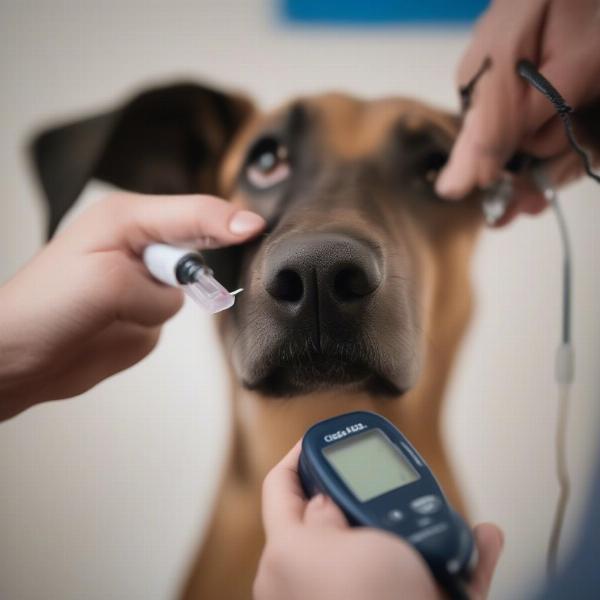Understanding your dog’s blood glucose levels is crucial, especially if they have diabetes. A glucose monitor for dogs allows you to track these levels at home, providing valuable insights into their health and helping you manage their condition effectively. This guide will explore the different types of glucose monitors, how to use them, and why they are an essential tool for diabetic dog owners.
Types of Glucose Monitors for Dogs
There are two main types of glucose monitors available for dogs: handheld meters and continuous glucose monitors (CGMs). Handheld meters require a small blood sample, usually obtained from the ear flap, while CGMs use a small sensor inserted under the skin to provide constant glucose readings. Both have their pros and cons, and the best choice for your dog will depend on their individual needs and your lifestyle.
Handheld Glucose Meters
Handheld meters are the most common type of glucose monitor for dogs. They are relatively inexpensive and easy to use, making them a good option for many pet owners.  Handheld Glucose Meter for Dogs However, they do require pricking your dog’s ear to obtain a blood sample, which some dogs may find uncomfortable.
Handheld Glucose Meter for Dogs However, they do require pricking your dog’s ear to obtain a blood sample, which some dogs may find uncomfortable.
Continuous Glucose Monitors (CGMs)
CGMs offer a more convenient and comprehensive way to monitor glucose levels. These devices provide continuous readings, eliminating the need for frequent finger-prick tests. While CGMs can be more expensive than handheld meters, they offer a wealth of information that can be invaluable in managing diabetes. They can alert you to high or low glucose levels, allowing you to take action quickly.
How to Use a Glucose Monitor for Dogs
Using a glucose monitor for dogs is a straightforward process, but it’s important to follow the manufacturer’s instructions carefully. For handheld meters, you’ll need to obtain a small blood sample from your dog’s ear flap. normal blood sugar level for dogs Clean the area with an alcohol swab and use a lancet to prick the skin. Apply the blood drop to the test strip and insert it into the meter. The meter will display the glucose reading within seconds. For CGMs, you’ll need to insert the sensor under your dog’s skin, following the instructions provided. The sensor will transmit glucose readings to a receiver or smartphone app.
Why Monitor Your Dog’s Glucose Levels?
Regular glucose monitoring is essential for managing diabetes in dogs. It helps you:
- Track the effectiveness of insulin therapy: Monitoring allows you to see how your dog’s body is responding to insulin and make adjustments as needed.
- Identify high and low glucose levels: Early detection of these fluctuations can prevent serious complications.
- Assess the impact of diet and exercise: You can see how different foods and activities affect your dog’s glucose levels.
- Provide valuable information to your veterinarian: Regular monitoring provides data that can help your vet fine-tune your dog’s treatment plan.
“Regular glucose monitoring empowers owners to take control of their dog’s diabetes management,” says Dr. Emily Carter, a veterinary endocrinologist. “It’s a vital tool for ensuring their pet’s health and well-being.”
Understanding the Results
Knowing what the numbers mean is just as important as taking the measurements. normal glucose levels for dogs Consult with your vet to understand the ideal glucose range for your dog and what to do if the readings are outside of this range. Don’t hesitate to contact your vet if you have any concerns about your dog’s glucose levels. best dog treats for diabetic dogs
Conclusion
A glucose monitor for dogs is an invaluable tool for managing diabetes and ensuring your furry friend’s health and happiness. Whether you choose a handheld meter or a CGM, regular monitoring empowers you to make informed decisions about your dog’s care. By understanding your dog’s glucose levels, you can work with your veterinarian to create a comprehensive treatment plan that keeps them healthy and active. blood glucose monitor for dogs
FAQ
- How often should I check my dog’s glucose levels? This depends on your dog’s individual needs and your vet’s recommendations.
- Are glucose monitors painful for dogs? Handheld meters require a small prick, which may cause momentary discomfort. CGMs are generally less invasive.
- What should I do if my dog’s glucose levels are too high or too low? Contact your veterinarian immediately.
- Can I use a human glucose meter on my dog? While some pet owners do this, it’s best to use a meter specifically designed for animals.
- Where can I purchase a glucose monitor for my dog? Your veterinarian can recommend a suitable monitor, or you can purchase one online or at a pet supply store.
- Are there any specific dog treats for diabetic dogs? Yes, there are special treats formulated for diabetic dogs that you can find at pet stores or online. lectade for dogs
- What are the signs of diabetes in dogs? Common signs include increased thirst, frequent urination, weight loss, and increased appetite.
ILM Dog is a leading international website dedicated to providing expert advice on dog care and wellbeing. We offer comprehensive information on everything from breed selection and health care to training, nutrition, and grooming. Whether you’re a new dog owner or a seasoned pro, ILM Dog has the resources you need to provide the best possible care for your furry companion. Contact us at [email protected] or +44 20-3965-8624 for expert advice and guidance.